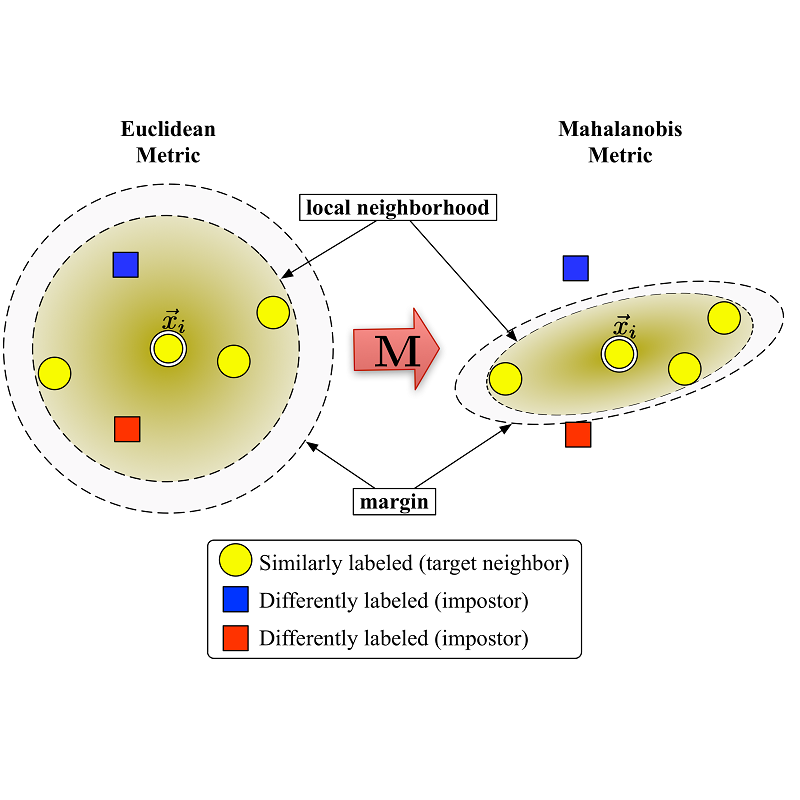Online metric learning has been widely exploited for large-scale data classification due to the low computational cost. However, amongst online practical scenarios where the features are evolving (e.g., some features are vanished and some new features are augmented), most metric learning models cannot be successfully applied to these scenarios, although they can tackle the evolving instances efficiently. To address the challenge, we develop a new online Evolving Metric Learning (EML) model for incremental and decremental features, which can handle the instance and feature evolutions simultaneously by incorporating with a smoothed Wasserstein metric distance. Specifically, our model contains two essential stages: a Transforming stage (T-stage) and a Inheriting stage (I-stage). For the T-stage, we propose to extract important information from vanished features while neglecting non-informative knowledge, and forward it into survived features by transforming them into a low-rank discriminative metric space. It further explores the intrinsic low-rank structure of heterogeneous samples to reduce the computation and memory burden especially for highly-dimensional large-scale data. For the I-stage, we inherit the metric performance of survived features from the T-stage and then expand to include the new augmented features. Moreover, a smoothed Wasserstein distance is utilized to characterize the similarity relationships among the heterogeneous and complex samples, since the evolving features are not strictly aligned in the different stages. In addition to tackling the challenges in one-shot case, we also extend our model into multishot scenario. After deriving an efficient optimization strategy for both T-stage and I-stage, extensive experiments on several datasets verify the superior performance of our EML model.
翻译:由于计算成本低,在大规模数据分类方面广泛利用了在线指标学习,因为计算成本低,大规模数据分类被广泛利用,然而,在各种特征正在演变的在线实际情景中(例如,一些特征消失,一些新特征得到增强),大多数指标学习模型无法成功地应用于这些情景,尽管它们能够有效地应对不断变化的实例。为了应对这一挑战,我们开发了一个新的在线数据学习模型(EML),用于渐进和衰减的特征,通过与瓦瑟斯坦光滑的宽度距离结合,可以同时处理实例和特征演变。具体地说,在我们的模型中,有两个基本阶段是转型阶段(T阶段)和继承阶段(I-级阶段)。对于T阶段,我们建议从消失的特征中提取重要信息,同时忽视非强化性知识,并将信息推向尚存的特征,将其转化为低级歧视性的测试空间。我们进一步探索各种模型的内在低级结构,以减少计算和记忆负担,特别是高度大尺度数据。对于第一阶段而言,我们从一个转变阶段(T-阶段)阶段(T-阶段)和高级阶段(I-阶段)阶段(I-阶段)的模拟阶段)的模拟阶段,我们从一个平稳模型阶段到一个阶段的模型阶段的运行阶段的阶段阶段阶段阶段的阶段的阶段特征特征变化变化性特征到另一个阶段到另一个阶段的变异式的模型,以及随后的变异式的模型的模型的模型的升级到一个阶段的模型的模型,将扩展到一个阶段的模型的模型,将扩展到一个阶段的模型到一个阶段的变式的变式的升级到一个变式的变到另一个的变式的变式的变式的变式的变式的变式的变到另一个的变式的变式的变式的变式的变式的变式的变式的变式的变式的变式的变式的变到另一个的变式的变式的变式的变式的变式的变。




